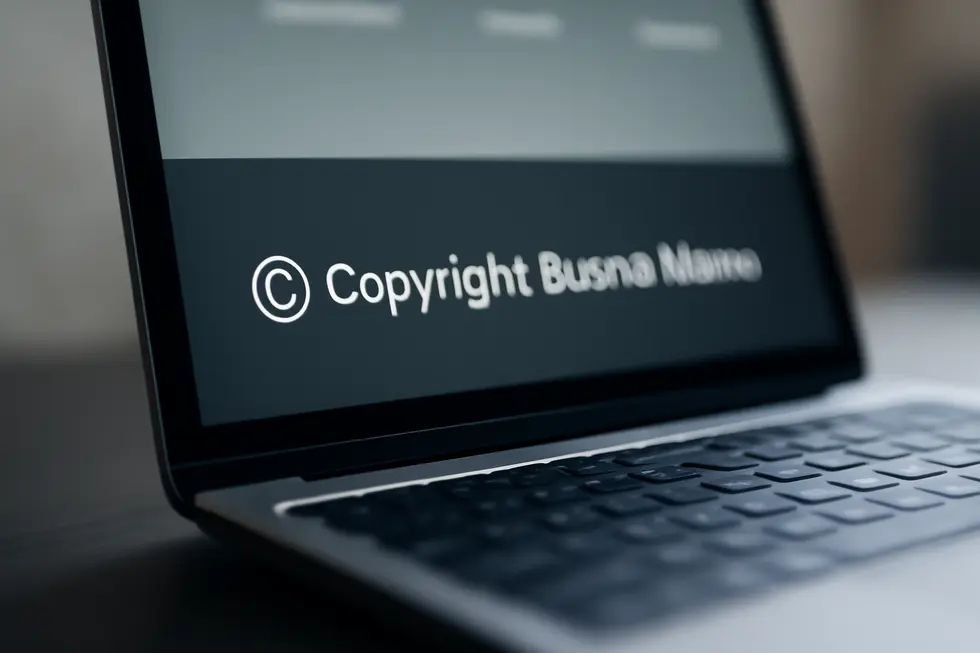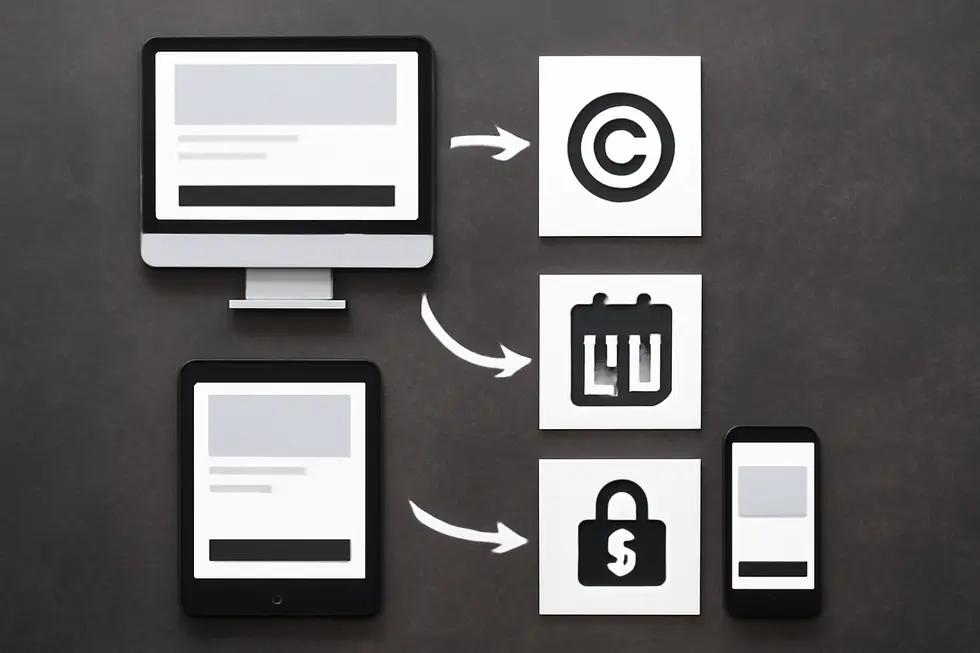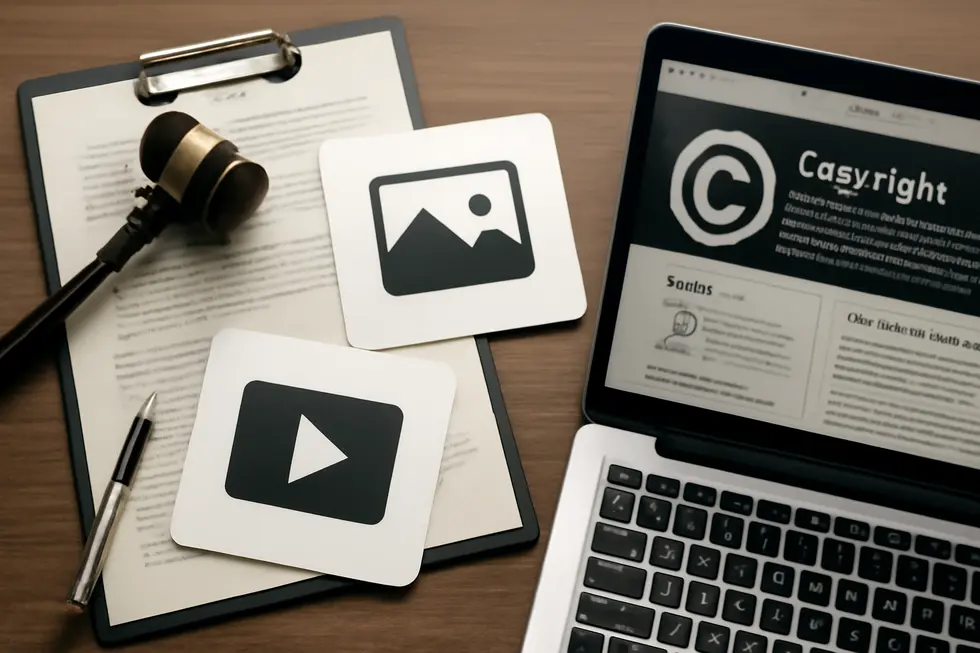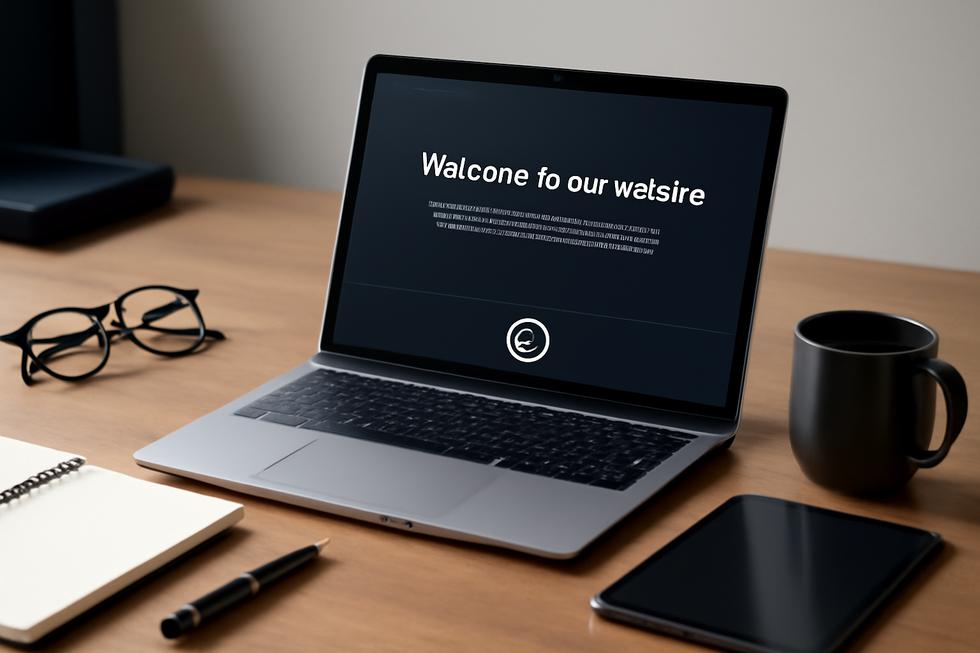Introduction
Copyright text on websites is a vital tool for business owners to communicate ownership and safeguard their digital content. While copyright protection exists automatically upon creation, clearly displaying a copyright notice enhances your legal standing and deters infringement. Understanding the components, best implementation practices, and advanced considerations can empower your business to protect its intellectual property thoroughly. The first chapter explores the essential components every website copyright text should have. The next section guides business owners through the best practices for implementing copyright notices seamlessly. Finally, the article discusses advanced considerations, including licensing and media-specific copyright claims, to address more complex content protection needs.
Tables of Contents
Chapter 1: Essential Components of Copyright Text for Website
- Key Building Blocks of Effective Copyright Text That Protect Your Website Content
- Crafting Effective Copyright Notices: Best Practices and Legal Significance for Website Protection
Chapter 2: Best Practices for Implementing Copyright Text for Website
- Strategic Legal Measures and Documentation for Enforcing Website Copyrights Effectively
- Strategic Placement, Compliance Audits, and Empowering Users: Crafting Effective Copyright Text on Your Website
Chapter 3: Advanced Copyright Text Considerations for Website Content
- Integrating Legal and Technical Safeguards for Robust Website Copyright Protection
- Navigating AI-Generated Content, Licensing, and Copyright Risk in Website Text
Chapter 1: Essential Components of Copyright Text for Website

1. Key Building Blocks of Effective Copyright Text That Protect Your Website Content
Crafting clear and effective copyright text for your website begins with understanding its fundamental components. A well-constructed copyright notice serves as a public declaration that the content is legally protected and identifies the copyright owner’s exclusive rights. The cornerstone of this notice is the copyright symbol ©, immediately followed by the year or range of years marking the publication or update, and the name of the copyright holder. For example, a standard notice might read: © 2025 Your Company Name, or when covering an extended period of maintenance and updates, © 2018–2025 Your Company Name. This concise trio signals to visitors and potential infringers the timeline and ownership of the protected content.
Beyond this essential format, outlining the scope of rights clarifies what the owner controls. Copyright grants exclusive authority over reproduction, distribution, public display, and creation of derivative works. Emphasizing these rights within the notice, either through phrases like “All rights reserved” or a clear statement of restricted use, helps deter unauthorized copying or commercial exploitation. Including explicit restrictions on use, such as prohibiting redistribution or modification without permission, sharpens the boundaries of acceptable interaction with the content.
It is important to underscore that copyright protection arises automatically once original content is fixed in a tangible medium—such as website text, images, code, or multimedia. There is no legal requirement to include a notice, yet this declaration significantly benefits the copyright owner by signaling ownership and possibly reducing damages if infringement occurs. The notice also dispels any ambiguity about originality and ownership, affirming that the material is the product of independent creation protected under law. This distinction matters since copyright protects only the specific expression of ideas, not the ideas themselves.
Some website owners choose to include additional elements to enhance clarity. Mentioning the typical duration of copyright—commonly the life of the author plus 70 years in the U.S.—can inform users about the lasting nature of the protection. When multiple types of content are present, such as images or software code, specifying separate copyright statements (e.g., “All images © 2023–2025 Your Company Name Photography”) can further refine legal claims.
To address potential questions or permissions, providing contact information within or adjacent to the copyright text facilitates communication. This transparency supports legitimate use requests and reduces infringement risks.
While disclaimers concerning fair use exceptions or third-party content may be added to clarify limitations, the core message of the copyright text should remain straightforward and authoritative. The combination of the symbol, date(s), owner’s name, and rights assertion builds a robust foundation for protecting website content.
For more detailed guidance and examples on crafting effective copyright statements suitable for website use, visit detailed copyright text guidance. This resource offers practical insights to help ensure your copyright text is both legally sound and communicative.
By mastering these key building blocks, website owners can confidently assert their rights and communicate the legal protections safeguarding their original works.
2. Crafting Effective Copyright Notices: Best Practices and Legal Significance for Website Protection
An effective copyright notice on a website serves as both a clear declaration of ownership and a practical deterrent against unauthorized use. While copyright protection attaches automatically when an original work is fixed in a tangible medium, including a properly formatted notice enhances that protection significantly. This notice typically incorporates three fundamental elements: the © symbol (or its variant like “Copyright”), the year of first publication or a range reflecting updates, and the name of the copyright owner. For instance, a notice styled as © 2013-2025 John Smith Photography succinctly communicates ownership and the active timespan of protection.
Placing this notice prominently—commonly in the footer of every webpage where protected content appears—ensures visitors understand the content is legally safeguarded. This visibility not only signals to users that the work is owned but also acts as a preventive measure against infringement. In legal contexts, it strengthens the copyright holder’s position by negating claims of “innocent infringement,” where a user might otherwise assert ignorance to avoid liability.
Beyond the standard elements, the notice can include phrases such as “All rights reserved” to emphasize comprehensive legal rights, or specify licensing terms if the content is distributed under licenses like Creative Commons. For websites featuring diverse media types, especially images, it is wise to tailor copyright statements to clarify ownership of specific content subsets—for example, “All images © 2023-2025 Your Company Name Photography.” This granularity helps avoid ambiguity and further protects distinct creative assets.
Legally, the date range in the notice is more than a formality. It marks the timeframe during which the work has been published or updated, assisting in infringement disputes by establishing a chronological context. Keeping this range current by updating the end year with substantive website changes reinforces ongoing protection claims. Although formal copyright registration is not a prerequisite for protection, it provides additional leverage when enforcement becomes necessary, including eligibility for statutory damages and attorney’s fees under certain jurisdictions.
The notice also implicitly refers to key legal concepts underpinning copyright: the protection of original expression (not mere ideas), the exclusive rights of reproduction, distribution, and adaptation held by the owner, and in some areas, moral rights that safeguard attribution and integrity of the work. Incorporating a well-crafted copyright notice complements these rights by publicly asserting them.
In summary, best practice involves consistently displaying a clear and accurate copyright notice on all relevant pages. Such a notice clarifies ownership, marks the publication timeline, and signals to all users the enforceable rights held by the website owner. This enhances legal standing and provides practical benefits, such as facilitating cease and desist procedures and DMCA takedown actions should infringement occur. For a more detailed guide on formatting and effective implementation, visit this comprehensive resource.
For further insights on copyright language tailored for business owners, explore this copyright language guide for business owners.
Chapter 2: Best Practices for Implementing Copyright Text for Website

1. Strategic Legal Measures and Documentation for Enforcing Website Copyrights Effectively
Implementing copyright text on a website goes beyond simply displaying the © symbol, year, and owner’s name. To truly safeguard your content, embracing a cohesive legal and procedural approach is essential. This involves registering your copyright, maintaining meticulous documentation, and having a proactive enforcement strategy, all of which form the backbone of effective copyright protection.
Registration is a fundamental step in establishing formal ownership of your website’s creative content. Though copyright protection exists upon creation automatically, registering with the appropriate copyright office creates a public record that can strengthen any future legal claims. Registration documentation such as application receipts, office correspondence, and certificates of registration should be carefully preserved. These documents serve as concrete proof of ownership and can be vital if infringement disputes arise.
Parallel to registration, maintaining a comprehensive trail of documentation about your creative works greatly enhances your ability to prove authorship and originality. This includes saving drafts, revisions, relevant metadata, and source files for all text, images, videos, and other media featured on your site. Using visible watermarks or embedding invisible digital markers like metadata tags and digital signatures further deters unauthorized reuse and supports claims of ownership. Keeping this material organized and securely stored ensures you can readily produce evidence if an infringement occurs.
Enforcement strategies begin with vigilant monitoring for unauthorized use of your content. This can include regularly scanning the web and social media platforms for copies of your work. Once potential infringement is identified, it is necessary to document violations thoroughly by capturing screenshots, noting dates, URLs, and any related details. Initial steps typically involve sending a cease and desist letter to the infringing party that clearly outlines your ownership and demands cessation of further unauthorized use.
For infringements found online, filing a Digital Millennium Copyright Act (DMCA) takedown notice with the hosting provider or platform often offers a swift remedy. This legal mechanism compels the removal of infringing material without needing immediate court intervention. However, if informal enforcement efforts and takedown notices fail to resolve the issue, consulting an intellectual property attorney becomes crucial. Formal legal action may then be pursued, including claims for statutory damages and attorney fees, to protect your rights fully.
Adopting these practices—registering your copyright, maintaining detailed documentation, monitoring content use, issuing cease and desist communications, utilizing DMCA takedown notices, and escalating to legal proceedings when necessary—builds a robust framework for protecting your website’s intellectual property. Each step supports and reinforces the others, thereby positioning you to defend your content confidently and effectively.
For additional insight on proactive legal protection and enforcement tactics, the article on copyright information example for business offers valuable guidance. Likewise, a thorough overview of DMCA takedown procedures is available from external sources such as this detailed DMCA takedown strategies guide.
2. Strategic Placement, Compliance Audits, and Empowering Users: Crafting Effective Copyright Text on Your Website
Implementing copyright text on a website goes beyond merely inserting a © symbol followed by a year and a company name. To effectively assert ownership and protect your digital content, a strategic approach that combines clear notice placement, diligent content auditing, and user education forms a solid foundation.
The most visible and practical step is the clear and consistent placement of the copyright notice. This is usually located in the footer of every page, where visitors naturally expect such legal information. A concise statement including the copyright symbol, the relevant year or range of years reflecting content updates, and the copyright holder’s full name establishes a public claim. Adding a phrase like “All rights reserved” reinforces that the content is fully protected, signaling to users and potential infringers the limitations on use. For example, a notice reading © 2025 Your Company Name. All rights reserved. clearly communicates ownership and the scope of protection. This level of transparency not only asserts your rights but can also strengthen your position in legal scenarios involving infringement.
However, clear notice placement alone isn’t sufficient. Equally vital is the ongoing auditing of website content to ensure compliance and avoid accidental infringement. Websites often contain diverse assets such as images, videos, text, and fonts sourced from creators, stock libraries, or contributors. Keeping meticulous records of the origin of every asset, including licenses or permissions, protects your site legally. Using organized systems like spreadsheets or project management tools to log the content type, source, license terms, and expiration dates fosters accountability and quick verification when needed. Regular audits help verify that all materials still have valid usage rights and comply with current copyright laws. This vigilance prevents surprises such as expired licenses or unintentional plagiarism that could result in costly disputes.
Moreover, websites that host user-generated content (UGC) face additional challenges. Educating users about copyright rules is an essential layer in defending intellectual property. This can be achieved by integrating prompts or reminders during content upload processes that encourage users to verify ownership or permission for the content they submit. Offering clear guidelines on permissible content types and outlining the consequences of violations empowers users to act responsibly. For sites with contributors or community members, providing accessible training materials on copyright principles, fair use, and ethical IP practices cultivates a culture of respect for creators. By promoting awareness, websites reduce legal risks and foster a trustworthy environment.
Bringing these elements together creates a comprehensive defense for your website’s intellectual property. The visible copyright notice asserts your claim, the detailed content audits ensure compliance, and the user education mitigates misuse or infringement. This multifaceted approach balances technical implementation with informed user participation, maximally protecting your site and reinforcing your rights as a content owner.
For deeper insights into handling copyright issues in digital content and user-generated platforms, LegalZoom’s guide on protecting original ideas offers practical advice on documentation, takedown procedures, and proactive notices: https://www.legalzoom.com/articles/three-ways-to-protect-your-original-idea
Additionally, the linked resource on copyright language for business owners provides valuable context for crafting clear and legally sound copyright texts tailored to online business environments.
Chapter 3: Advanced Copyright Text Considerations for Website Content

1. Integrating Legal and Technical Safeguards for Robust Website Copyright Protection
Protecting website content today demands a strategic blend of legal rights and technical defenses tailored to the digital environment. While copyright law inherently secures original website content from the moment of its creation, explicitly asserting ownership through a precise copyright notice strengthens this protection and clarifies usage boundaries for visitors and potential infringers.
Legal measures underpin this foundation by granting website owners exclusive rights to reproduce, distribute, and display their creative works. These rights are enforceable through civil litigation against unauthorized use — even if only part of the content is copied. Clear copyright notices, which typically include the © symbol, relevant year or year range, and copyright holder’s name, play a crucial role here. Adding phrases like “All rights reserved” or specifying licensing terms (such as Creative Commons) further delineates permitted uses and discourages infringement. Such documentation not only signals ownership but also supports statutory damage claims and eases enforcement should infringement occur. Legal frameworks, such as the Copyright Act, provide the backbone for these protections, emphasizing the importance of maintaining up-to-date and precise copyright statements.
Beyond these legal tools, technical measures serve as pragmatic barriers against unauthorized copying and misuse. Common defensive tactics include manipulating website code—using JavaScript, CSS, and HTML—to disable right-click functionality, text selection, and copy-paste actions. While these restrictions are not foolproof, they deter casual theft and automated scraping. Additionally, obfuscating HTML or encrypting source code adds layers of complexity that discourage direct copying.
More advanced controls involve server-side access management, restricting sensitive or premium content exclusively to authenticated users. By regulating who can view or download particular resources, site owners limit the risk of unauthorized distribution.
Digital Rights Management (DRM) technologies elevate protection by embedding usage restrictions directly into digital content. DRM can prevent copying, sharing, downloading, or even screen capturing, ensuring that only authorized users access protected material. Despite their efficacy, DRM solutions often face criticism for overreach and user inconvenience, tracing back to high-profile cases where intrusive measures harmed reputations and customer trust.
Complementing these approaches, emerging brand protection software powered by AI and machine learning offers sophisticated monitoring capabilities. These tools scan the internet, social media, marketplaces, and even darknet platforms to detect counterfeit or infringing content. When such violations are discovered, these systems can automate enforcement actions, accelerate takedowns, and safeguard intellectual property and brand integrity across diverse digital channels.
In contexts involving AI-generated or sourced content, ethical and legal vigilance is essential. Properly licensing material, respecting copyrights, and transparently acknowledging sources help avoid infringement risks. Uploading protected content to AI tools lacking privacy guarantees raises additional legal and ethical concerns.
Ultimately, effective website copyright protection arises from harmonizing statute-backed rights with pragmatic technical strategies. This dual approach addresses evolving threats ranging from casual copying to sophisticated digital piracy. For an in-depth exploration of techniques and legal contexts surrounding website content protection, see this detailed coverage on website content protection.
2. Navigating AI-Generated Content, Licensing, and Copyright Risk in Website Text
The rise of AI-generated content introduces complex challenges to website copyright practices. Unlike traditional human-authored works, AI-generated material does not qualify for copyright protection in the United States because copyright law requires a human creator to claim authorship. Instead, any copyright over such content typically belongs to the individual or organization that operates or owns the AI system—not the AI itself. This distinction is crucial when crafting copyright text for a website incorporating AI-generated materials.
Moreover, the legal terrain is complicated by how AI models are trained. These models often ingest vast amounts of data scraped from the internet, including copyrighted works that may have been used without permission. If AI-generated content substantially resembles any protected materials, it can expose website owners to allegations of infringement. Given this uncertainty, it is prudent to rely on AI training datasets drawn from licensed or public domain sources to minimize legal risks.
Licensing plays an essential role in managing these uncertainties. Clear licensing agreements governing AI usage should outline the rights retained by the user, permitted uses of AI-generated content, and commercial restrictions when applicable. These policies not only establish legal boundaries but also provide transparency for website visitors and partners. Some platforms insist on attribution for AI-crafted content, reflecting growing ethical and legal awareness around disclosure. Including such statements in copyright text or site policies supports trust and aligns with evolving norms.
Risk management strategies extend beyond licensing into operational safeguards. Many organizations employ AI-powered content filtering tools to scan for sections of generated material that closely mimic copyrighted works. This proactive moderation helps prevent the publication of infringing content, thus reducing the likelihood of DMCA takedown notices or legal complications. Yet, technology alone is insufficient—human oversight remains paramount. Editorial review of AI outputs ensures content originality and brand consistency while providing an opportunity to catch potential copyright violations before public release.
Because AI-generated works stand in a unique legal position, website copyright text must reflect these complexities subtly yet effectively. While standard notices including the © symbol, ownership name, and year remain essential, additional disclaimers or policy statements addressing AI content use and related licensing can clarify ownership and usage rights. This layered approach to copyright assertions helps communicate the site’s commitment to respecting intellectual property and managing AI-specific risks.
By integrating sound licensing practices, transparent disclosure, human editorial control, and AI-assisted content moderation, website operators can responsibly harness AI tools without compromising legal protection. For a deeper understanding of AI-related copyright frameworks and risk mitigation, consult Brooklyn Public Library’s detailed guide on copyright and AI art. This guidance complements fundamental copyright knowledge and bolsters comprehensive site content management strategies.
For further insights into copyright language best suited for businesses navigating intellectual property challenges, explore related materials such as copyright language for business owners.
Final thoughts
A well-written copyright text is more than a formal statement — it is a cornerstone for communicating and defending your business’s rights over your website content. By including essential elements such as the © symbol, correct year or year range, and your business name, you set a clear ownership foundation. Implementing best practices, including consistent placement and timely updates, strengthens this claim and enhances visibility for visitors and potential infringers alike. For businesses with diverse or multimedia content, advanced copyright and licensing considerations help clarify complex rights while reinforcing protection. Ultimately, investing time in mastering copyright text not only preserves your digital assets but also projects professionalism and diligence in your brand’s online presence.
Your IP is the foundation of your success – let’s protect it together before it’s too late. We can’t wait to help you turn your ideas into legally secured assets.
About us
undefined



Your point of view caught my eye and was very interesting. Thanks. I have a question for you.